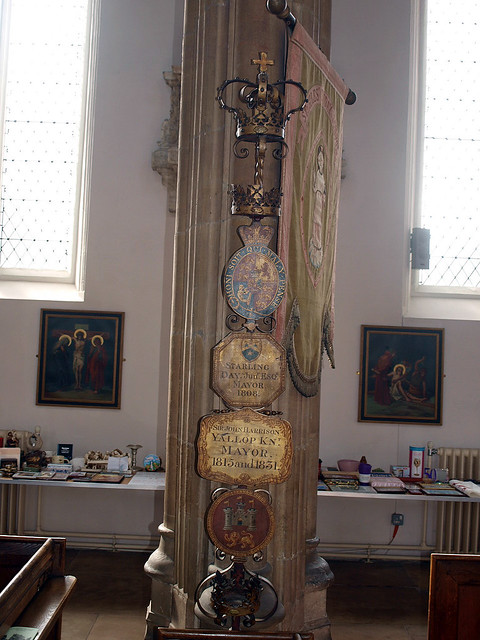ST GILES, St Giles Street. The tallest tower of any Norwich parish church, 120 ft high, and building up beautifully when seen from the E above the chancel and nave gables. On the top is a pretty little cupola, effective from afar. This dates from 1737. The church was built in the late C14, but if the chancel built by Phipson in 1866-7 represents anything of the original state, it must have been Dec. Perp aisle and clerestory windows, Perp W doorway with niches, Perp W window of five lights, Perp four-light bell-openings with transom. The S porch is ashlar-faced; it has a top frieze with shields in running tendrils, a pretty cresting, and a fan-vault inside. So this must be a hundred years later than the rest. Arcades of five bays. The piers have an odd design. Four shafts and many thin mouldings in between, but more towards the nave than towards the aisles. The chancel arch corresponds to the arcade arches. Three tiers of niches l. and r. of it. Beautiful hammerbeam roof with the bosses supporting the hammerbeam and the braces rising on it constructed in one unbroken curve from the wall-posts to the top. No collar-beams. The angels against the hammerbeams cut across the braces and finish at the wall-posts. This is an early stage of the hammerbeam roof, as Cautley and Crossley explain. - FONT. Faces on the underside; flowers and little shields against the bowl. - SWORD RESTS. Five sets of them. - PLATE. A large London made set of 1738-9. - MONUMENTS. Brasses to Richard Purdaunce d. 1436 and wife, 45 in. figures, and to Robert Baxter d. 1432 and wife, 39 in. figures, both uncommonly good (nave). - (Chalice Brass to John Smyth d. 1499.) - Thomas Churchman 1' 1742 by Sir Henry Cheere, tablet with a very civilized frame and three cherubs’ heads below. - William Offley d. 1767. By no means Rococo in spiritedness, but violently Rococo in composition, i.e. demonstratively asymmetrical. The ‘predella’, oval inscription plate, and ledge for the top urn create a most unexpected zigzag movement upward. The monument is nearly identical with the Dame Anne Astley at Melton Constable d. 1768. - Sir Samuel Churchman d. 1781. By Rawlins. Good and neo-classical. On the sarcophagus a relief. Against the obelisk above, a portrait in an oval medallion. - Several other tablets are enjoyable.
St Giles’s church, just above the marketplace and the City Hall, was founded in the Conqueror’s day, rebuilt at the end of the 14th century in 15th-century style, and is now an imposing structure of flint (except for the stone porch), dominated by a tower 113 feet high. The highest tower of the old city churches, it was used as a beacon in the 16th century, and has among its possessions an old cresset like a wrought-iron basket. The porch is enriched with niches, and a fine cornice of shields under trailing vine and cresting; it is entered by a door with fine tracery, and its upper room rests on a lovely fan-vaulted roof, the only one in the church porches of Norwich. The interior is stately with lofty arcades between the clerestoried nave and aisles, fine windows filling it with light, and old roofs. On the ends of the hammerbeams of the nave roof 12 big angels with outspread wings hold shields with arms. The massive tower arch soars to the roof, and in front of it stands the font carved with flowers, tracery, angels, and shields, the bowl medieval, the rest 19th century. Shining in a tiny window in the gable of the chancel arch is the patron saint. The chancel itself is 1866, the old one having been destroyed in Elizabeth’s day; there are six angels in its roof. The fine brass of a 15th-century mayor shows Richard Purdance of 1430 with a thin bearded face, wearing a robe edged with fur and standing on a dog; and his wife in draped headdress, a dog in the folds of her gown. Two portraits on a brass of 1432 are of Robert Baxter and his wife. That of John Smith, a priest of 1489, has a chalice and wafer. There are many 18th and 19th-century mace rests, and a loose stone of the Norman church is preserved for us to see. The parish umbrella, 150 years old, is in the Castle Museum.



No comments:
Post a Comment